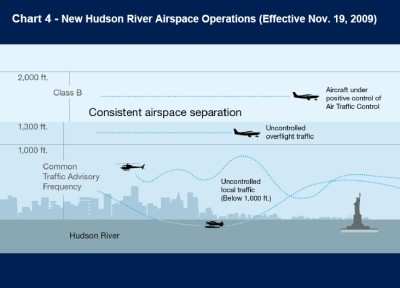Mon, Nov 16, 2009
Modifications Designed To Enhance Safety
 The FAA has finalized a federal rule, effective November 19,
2009, that will enhance safety by separating low-altitude, local
aircraft flights over the Hudson River from flights transiting
through the river airspace. "Better separation of aircraft
means a higher margin of safety," said U.S. Transportation
Secretary Ray LaHood. "These new rules will ensure that aircraft
can operate safely in the busy Hudson River airspace."
The FAA has finalized a federal rule, effective November 19,
2009, that will enhance safety by separating low-altitude, local
aircraft flights over the Hudson River from flights transiting
through the river airspace. "Better separation of aircraft
means a higher margin of safety," said U.S. Transportation
Secretary Ray LaHood. "These new rules will ensure that aircraft
can operate safely in the busy Hudson River airspace."
"These changes will define separate corridors for aircraft
operating locally and those flying along the Hudson River area,"
said FAA Administrator Randy Babbitt. "Separating aircraft on
different missions and improving pilot situational awareness will
add more layers of safety to this high-demand airspace."
The rule also now requires pilots to follow safety procedures
that were previously recommended, but were not mandatory. In a new
Special Flight Rules Area over the Hudson and East Rivers, pilots
must:
- Maintain a speed of 140 knots or less.
- Turn on anti-collision and aircraft position/navigation lights,
if equipped.
- Self-announce their position on specific radio
frequencies.
- Carry current charts for the airspace and be familiar with
them.

In an exclusion zone below 1,300 feet over the Hudson River,
pilots must announce their aircraft type, position, direction and
altitude at charted mandatory reporting points and must stay along
the New Jersey shoreline when southbound and along the Manhattan
shoreline when northbound.
Pilots transiting the Hudson River must fly at an altitude
between 1,000 feet and 1,300 feet. Local flights will operate in
the lower airspace below 1,000 feet.
The rule also will incorporate provisions of an October 2006
NOTAM that restricted fixed-wing aircraft in the exclusion zone
over the East River to seaplanes landing or taking off on the river
or those specifically approved by FAA air traffic control.
All three updated pilot charts that local fixed wing and
helicopter pilots use for navigation will include these airspace
changes on November 19, 2009. The FAA will conduct seminars
and coordinate with pilot groups to make pilots aware of the new
requirements. The FAA also has developed an online training program
that covers flight operations in the New York area.
More News
Also: B-29 Superfortress Reunion, FAA Wants Controllers, Spirit Airlines Pulls Back, Gogo Galileo Van's Aircraft posted a short video recapping the goings-on around their reorganiz>[...]
Light Gun A handheld directional light signaling device which emits a brilliant narrow beam of white, green, or red light as selected by the tower controller. The color and type of>[...]
"The journey to this achievement started nearly a decade ago when a freshly commissioned Gentry, driven by a fascination with new technologies and a desire to contribute significan>[...]
"Our driven and innovative team of military and civilian Airmen delivers combat power daily, ensuring our nation is ready today and tomorrow." Source: General Duke Richardson, AFMC>[...]
Aircraft Conflict Predicted conflict, within EDST of two aircraft, or between aircraft and airspace. A Red alert is used for conflicts when the predicted minimum separation is 5 na>[...]
 Airborne 04.16.24: RV Update, Affordable Flying Expo, Diamond Lil
Airborne 04.16.24: RV Update, Affordable Flying Expo, Diamond Lil ANN's Daily Aero-Term (04.20.24): Light Gun
ANN's Daily Aero-Term (04.20.24): Light Gun Aero-News: Quote of the Day (04.20.24)
Aero-News: Quote of the Day (04.20.24) Aero-News: Quote of the Day (04.21.24)
Aero-News: Quote of the Day (04.21.24) ANN's Daily Aero-Term (04.21.24): Aircraft Conflict
ANN's Daily Aero-Term (04.21.24): Aircraft Conflict




